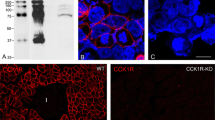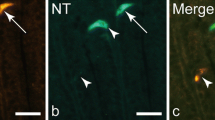Summary
Monoclonal antibodies raised to pancreatic glucagon were tested for their ability to detect glucagon-containing endocrine cells in material processed for light and electron microscopy. Samples from man, baboon and rat were used in this investigation. Two antibodies were specific for the pancreatic islet A cells, the remainder detected both pancreatic and enteric endocrine cells.
In man and baboon the glucagon-containing cells were confined to the pancreas, lower small intestine and colon. In the rat the distribution was extended to include the corpus of the stomach and the jejunum. The cells identified in the ileum and colon were of three morphological types endocrine, paracrine (type 1) with a single basal process and paracrine (type 2) with multiple small cytoplasmic processes.
These antibodies also detected cells in material fixed by conventional methods for electron microscopy. The ultrastructural appearance of the baboon pancreatic glucagon-containing ultracellular secretory granules were demonstrated to be clearly distinct from those described previously in man and rat. The secretory granules averaged 330±23 nm and lacked the characteristic clear outer halo seen in the other two species.
Similar content being viewed by others
References
Baetens D, Rufener C, Srikant C, Dobbs R, Unger R, Orci L (1976) Identification of glucagon-producing cells (A cells) in dog gastric mucosa. J Cell Biol 69:455–464
Bataille D, Gepach C, Tatemoto K (1981) Bioactive enteroglucagon (oxyntomodulin): Present knowledge on its chemical structure and its biological activities. Peptides 2:134–141
Bendavan M, Zollinger M (1983) Ultrastructural localization of antigenic sites on osmium-fixed tissues applying the protein A-gold technique. J Histochem Cytochem 31:101–109
Buchan AMJ, Ingman-Baker J, Levy J, Brown JC (1982) A comparison of the ability of serum and monoclonal antibodies to Gastric Inhibitory polypeptide to detect immunoreactive cells in the gastroenteropancreatic system of mammals and reptiles. Histochemistry 76:341–349
Coons AH, Leduc EH, Connolly JM (1955) Studies on antibody production 1. A method for the histochemical demonstration of specific antibody and its application to a study of the hyper-immune rabbit. J Exp Med 102:49–59
Ferri G-L, Harris A, Wright NA, Bloom SR, Polak JM (1982) Quantification of endocrine cells in whole intestinal crypts and villi. Histochem J 4:692–695
Frens G (1973) Controlled nucleation for the regulation of the particle size in monodisperse gold solutions. Nature (Phys Sci) 241:20–32
Gregor M, Rieken E-O (1985) Production and characterization of N-terminally and C-terminally directed monoclonal antibodies against pancreatic glucagon. Gastroenterology 89:571–580
Holst JJ (1983) Gut glucagon, enteroglucagon, gut glucagon-like immunoreactivity, glicentin — Current status. Gastroenterology 84:1602–1613
Larsson L-I, Goltermann N, De Magistris L, Rehfeld JF, Schwartz TW (1979) Somatostatin cell processes as pathway for paracrine secretion. Science 205:1393–1395
Ravazzola M, Orci L (1980) Glucagon and glicentin immunoreactivity are topographically segregated in the A granule of the human pancreatic A cell. Nature 284:66–67
Sagor GR, Al-Mukhtar MY, Ghatei MA, Wright NA, Bloom SR (1982) The effect of altered luminal nutrition on cellular proliferation and plasma concentrations of enteroglucagon and gastrin after small bowel resection in the rat. Br J Surg 69:14–18
Solcia E, Buffa R, Capella C, Fiocca R, Fontana P, Crivelli O (1979) Immunohistochemical characterization of gastroenteropancreatic endocrine cells and related multihormonal cells. Problems, pitfalls and facts. In: Miyoshi A (ed) Gut peptides: Secretion, function and clinical aspects. Elsevier Biomedical, Amsterdam, pp 303–309
Sternberger L (1979) Immunocytochemistry. 2nd edn. Wiley and Sons, New York
Sutherland S, de Duve C (1948) Origin and distribution of the hyperglycemic-glycogenolytic factor of the pancreas. J Biol Chem 175:663–674
Thim L, Moody AJ (1981) The primary structure of porcine glicentin (proglucagon). Reg Pep 2:139–150
Unger RH, Ketterer H, Eisentraut AM (1966) Distribution of immunoassayable glucagon in gastrointestinal tissues. Metabolism 15:865–867
Author information
Authors and Affiliations
Rights and permissions
About this article
Cite this article
Buchan, A.M.J., Gregor, M. & Riecken, E.O. Immunocytochemical characterization of glucagon-immunoreactive cells using monoclonal antibodies to pancreatic glucagon. Histochemistry 87, 79–83 (1987). https://doi.org/10.1007/BF00518728
Received:
Accepted:
Issue Date:
DOI: https://doi.org/10.1007/BF00518728




